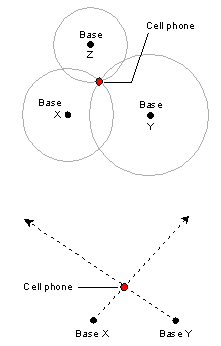Triangulation is a process by which the location of a radio transmitter can be determined by measuring either the radial distance, or the direction, of the received signal from two or three different points. Triangulation is sometimes used in cellular communications to pinpoint the geographic position of a user.
The drawings below illustrate the basic principle of triangulation. In the scenario shown by the top drawing, the distance to the cell phone is determined by measuring the relative time delays in the signal from the phone set to three different base stations. In the scenario shown by the bottom drawing, directional antennas at two base stations can be used to pinpoint the location of the cell phone.

Triangulation is difficult to carry out unless the person using the cell phone wants to be located. This might be the case, for example, in an emergency situation. Triangulation is the method by which the so-called 911 cell phones work.
Triangulation apparatus can be confused by the reflection of signals from objects such as large steel-frame buildings, water towers, communications towers, and other obstructions. For this reason, at least two independent triangulation determinations should be made to confirm the position of a cell phone or other radio transmitter.
A more sophisticated form of triangulation is used by the Global Positioning System (GPS).






























